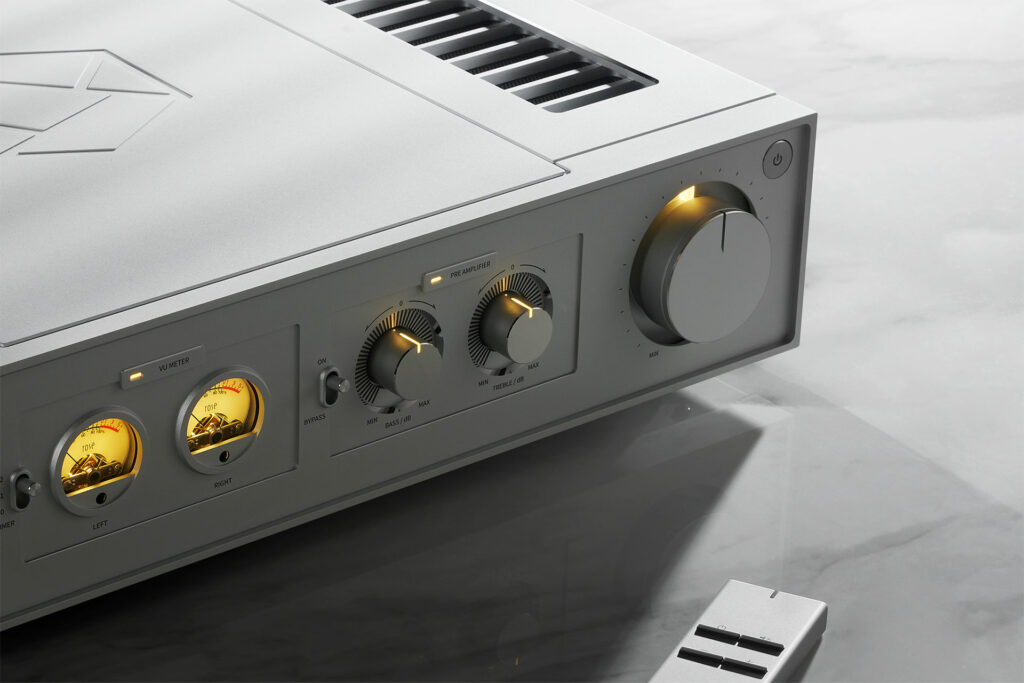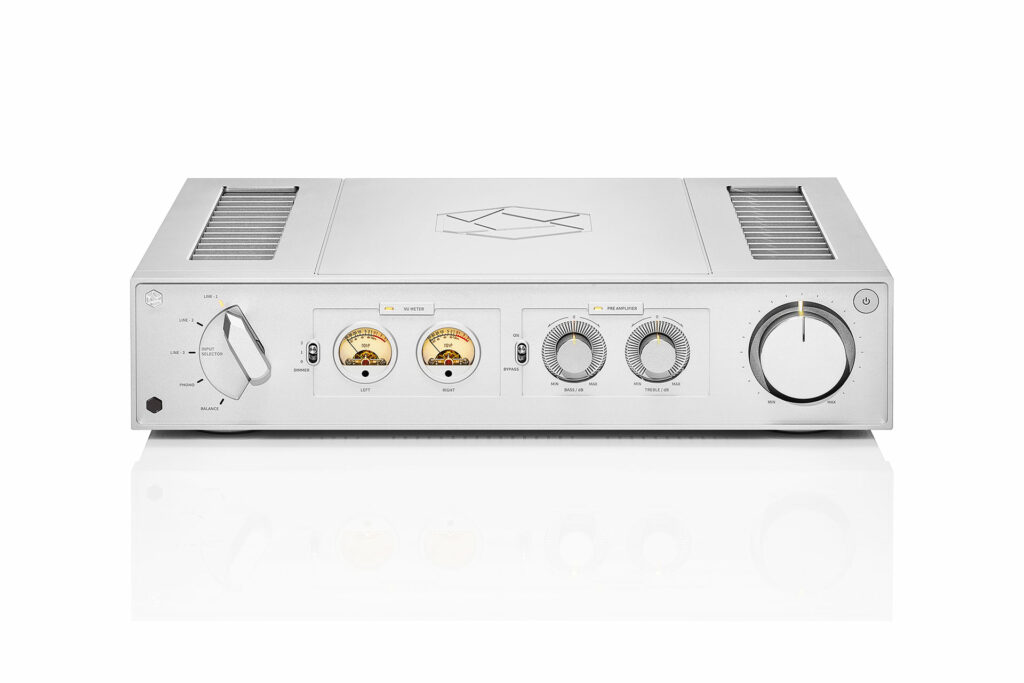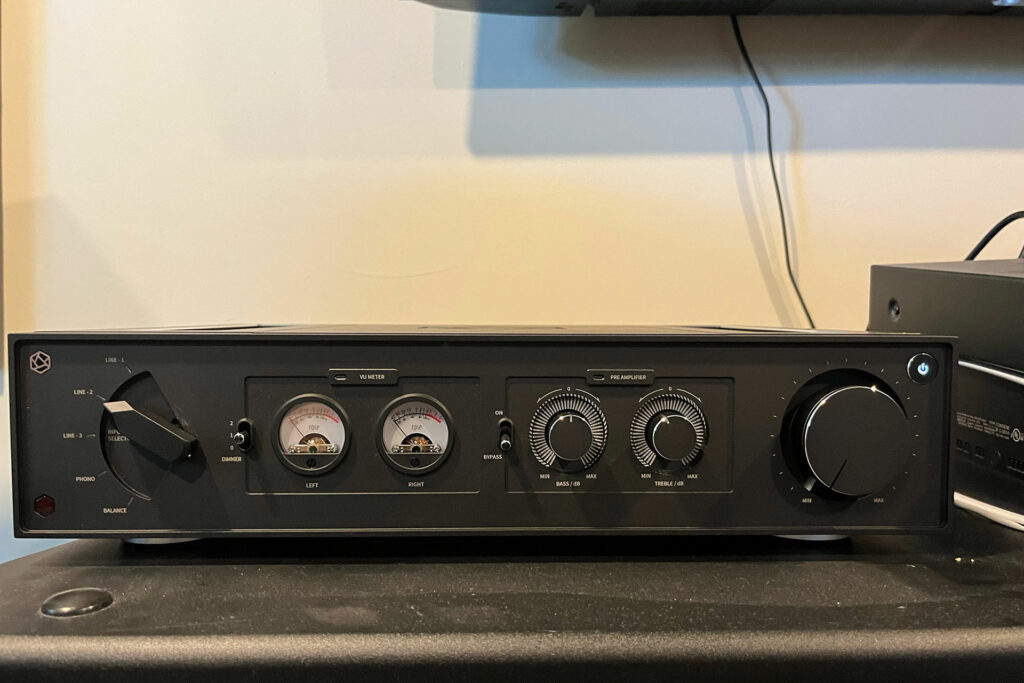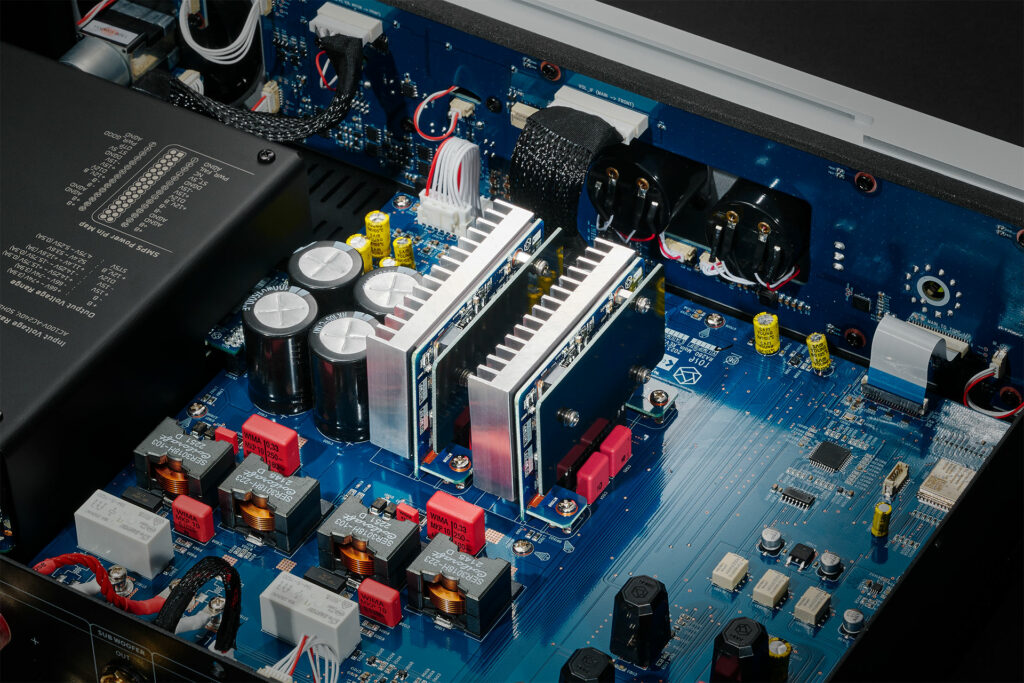Few brands have caught my eye over the last 12 months as much as has HiFi Rose. They are among the few companies in the audiophile market that look like they are making some changes in their products. We see that from HiFi Rose in their product design, and their willingness to use GaN FET Class AD for their amplifiers, as well as going to big bright LED screens on some of their products. Typically, there is nothing daring about an integrated amplifier. But the HiFi Rose RA280 has a unique exterior design with gauges, and the ability to toggle the coloring of the gauges and knobs between white light, which makes it feel more modern, and yellow light, which offers some vintage appeal. No light at all is also an option. Additionally, HiFi Rose built the amplifier section as completely separated mono amplifier modules that output 250 watts each or 500 watts when used in stereo. Lastly, and in some ways this is what makes this integrated amplifier really unique, is they chose to include an analog-only section. You get a moving magnet input with ground, and three other RCA analog inputs. I have reviewed a lot of integrated amplifiers over the last year, and I would be remiss if I didn’t say that this one is truly one of a kind. At $2,995, this integrated amplifier fits into the part of the market where you usually get a lot of goodies, so let’s take a closer look.

What Makes the HiFi Rose RA280 Integrated Amplifier So Special?
- The Class A/D amplifiers used by HiFi Rose are special! It is amazing that they are able to fit 500 watts of power into a box that is 16.9 inches wide, four inches tall, and 14 inches deep. Oh, and that isn’t even mentioning how good those 500 watts sound … The amplifier section sounded neutral and, at higher volumes, I wasn’t able to detect any distortion or any notable coloration. You could make the argument that the HiFi Rose RA280 is worth its price just to get the amplifier.
- A unique modern look. The RA280 borrows some of its aesthetic from its big brother the RA280, which had a very industrialized, almost steampunk look and feel to it, with its gears and dials. In this way, the RA280 is much cleaner and more streamlined, as it has one clean line of dials and gauges. Surprisingly, the coloring of the gauges also really did affect the look and feel of the integrated amplifier as well. I enjoyed how the yellow light made the product feel like it was vintage.
- Few modern products are THIS easy to use. One of the really nice things about this product being completely analog in its preamplifier section is that it is so easy to use. You don’t need to worry about any network connection issues that can making streaming an annoyance or setting up a Bluetooth connection and then ensuring your phone calls and other tech noises are protruding though your music. It’s plug in your source, turn it on, and you’re ready to go.
Why Should You Care About the HiFi Rose RA280 Integrated Amplifier?
There are not a lot of analog-only integrated amplifiers on the market today, fewer still have balanced (XLR) inputs, and even fewer have 500 watts of power (to be honest, the only one I found was the Marantz Model 10, and it retails at $15,000, which is more than five times the price of the HiFi Rose RA280, so it is far from an apples to apples comparison). So, if you’re looking for a great analog experience with a big-time amplifier, then you should definitely be taking a look at the HiFi Rose RA280 integrated amplifier.

Some Things You Might Not Like About the HiFi Rose RA280 Integrated Amplifier
- There is no digital section. Many people, when they are looking for an integrated amplifier, are hoping for it to be an all-in-one box. The HiFi Rose RA280 isn’t that, unless you are an analog-only listener. There’s no internal DAC, but good ones can be hand in the three-figure range.
- The remote control isn’t the most useful. Due to the nature of everything being analog, all you can control on the remote is turning the integrated amplifier on or off and adjusting the volume. You cannot change the source, and you cannot adjust the bass or treble. Those functions will require you to get up from the listening position to make those adjustments manually.
Listening to the HiFi Rose RA280 Integrated Amplifier …
I ran this integrated amplifier with the MartinLogan Motion XT F100 floorstanding speakers, and the Pro-Ject X1 B turntable. I AB-tested all these tracks with a Cambridge Audio EVO 150 DeLorean Edition, using the same MartinLogan Motion XT F100 floorstanding speakers, Pro-Ject X1 Turntable.
One of the first tracks I listened to was “Neighborhood #1 (Tunnels)” (on Vinyl) from Arcade Fire’s 2004 album Funeral. One of the first things I noticed when I AB-tested this track with the Cambridge EVO 150 was just how neutral the sound was with the HiFi Rose RA280. When played side by side with the Cambridge, the HiFi Rose RA280 has a noticeably warmer (a bit colored) sound to it. The other thing that I noticed from this track through the RA280 is the lack of production value that was in the track. It at times sounds like the sound is coming from a box. This isn’t a knock on the integrated amplifier, it’s more that it is showing you that audiophile-grade equipment can expose the flaws of a recording, in this case, recordings that were done in the musician’s apartment, in combination with a recording studio that is far from world-class, but this is to be expected from independent artists on their debut albums. Otherwise, the HiFi Rose RA280 was able to reproduce the piano parts realistically, it has no issues with the midrange sounds that were produced by the guitars, and you could easily separate the bass guitar, which can sometimes be a challenge on these recordings.
Another track that I used was “Stardust” (on Vinyl) from Wynton Marsalis’ 1984 album Hot House Flowers. This jazz track features a full orchestra, which makes up part of this Grammy Award-winning effort from Marsalis. Marsalis’ trumpet helps push the headroom in which you might be looking for that power, as he is able to achieve higher notes from his trumpet on this somber track. The midrange comes through strong, as well as the cello and violas, and you do get a hint of the bass when the tuba comes in. There are so many instruments to pick up on this recording, and the HiFi Rose RA280 was able to reproduce them individually, while still maintaining the semblance of the orchestration.
The last track I used to test the HiFi Rose RA280 integrated amplifier was “Animal” (on Vinyl) from Pearl Jam’s 1993 sophomore album Vs. This 1990s-era grunge track is always great when you want to turn the volume up. The amplification, as you would imagine, had no handles handling louder volumes. There wasn’t a point where I was able to hear any added distortion, as all of the instruments sounded just as fuzzy and dirty as Brendan O’Brien intended when he produced the album. The soundstage was also intact, as it was easy to close my eyes and feel like the music was happening right in front of me. The grooves were also very present between the bass guitar and the drums, which helps keep the pace of this track together.
Will the HiFi Rose RA280 Integrated Amplifier Hold Its Value?
Today HiFi Rose might not be a blue-chip brand (I could see this changing in the future with the quality of the products I have seen from them, but they are kinda new), it would be surprising if the RA280 integrated amplifier didn’t hold its value well. This product is too new to know with any certainty, as there are not any on the resale market, but with the strength of the amplifier section alone, I could see this product being sought after in the used market, where the consumer could use the money they save on this to add a great DAC or streamer to really round out their experience.

What is the Competition for the HiFi Rose RA280 Integrated Amplifier?
The Cambridge Audio EVO 150 ($3,000) fits as a comparison with both units coming in at nearly the same price point. These devices, while in the same price category, are very different. The EVO 150 is certainly capable, with power at 150 watts, but it still pales in comparison to the 500 watts the HiFi Rose RA280 provides. However, the Cambridge Audio EVO 150 does come with a streamer built-in, an LED screen on the front, and a full digital section, including HDMI.
If you want a digital section, maybe the HiFi Rose RS520 ($3,700) is for you. The RS520 essentially serves as the digital side, while the RA280 serves as the analog side. Both products feature 500 watts of Class A/D GaN FET amplifier power, but with the RS520, you get a full digital section with virtually no analog. So, if you want HDMI and those types of goodies, and the same great amplifier, get the RS520. Just remember that this product does not have a dedicated subwoofer output like the RA280 does.
The NAD C 3050 ($1,800), when talking about integrated amplifiers in this price range, is always worth mentioning. This product is such a great value with the BluOS component added in. You have your streaming built in, 200 watts of power and a full digital section, to go along with subwoofer out and a phono stage. This is a different product than the HiFi Rose RA280, but if you’re looking for an integrated amplifier that can do everything, and for less money, you should consider the NAD C 3050.

Final Thoughts on the HiFi Rose RA280 Integrated Amplifier …
The HiFi Rose RA280 is a great integrated amplifier for the right person, and if you’re that person, you are going to just love this component. Who is that right person, you ask? It is going to be someone who already has a strong-performing DAC and looking to add the right amplifier into the mix without buying separates, or you’re someone who loves listening to an analog source (today, that is likely vinyl), and you’re looking for a great amplifier without also going to separates. I continue to bring up the amplifier, because ultimately it is the RA280’s greatest selling feature. I truly believe that the price of this device is worth it just for the amplification that it provides, while its sleek exterior and analog preamplifier are a great bonus. This isn’t the typical integrated amplifier that is happy to be pretty good at a bunch of things, HiFi Rose has designed a integrated amplifier that knows what it is and what it does well, so that you can add the components you want to round out the experience for yourself. I love this boldness from HiFi Rose, and it is this frame of thought that allows them to build great products.




I don’t think you got the class of amp right, specs say a Class A/D using GaN mosfets in a switching scheme.
Publisher’s note: post publication, we changed a “fat finger” error from Class A/B to Class A/D which is how HIFIROSE indicates their switching amps.
Contradictory and somewhat confusing and inaccurate review, early on you state the HIFIROSE RA280 “ I noticed when I AB-tested this track with the Cambridge EVO 150 was just how neutral the sound was with the HiFi Rose RA280 …then a paragraph later u describe the sound as “warm” not neutral…you confusingly mention 500 watts of power but the relevant stero power per channel is 250 watts into 8 & 4 Ohms …the Evo 150 is 150 into 8 ohms but min 250 Watts into 4 ohms (stereophile actually achieved 282 watts into 4 Ohms as tested ….seems to me the Evo 150 in thenreal world is as powerful but has much more functionality streamer Dac ect for less money ..in the real World these are readily available for circa £1600 …so the HIFI ROSE dosnt offer any where near enough for its elevated made in Korea price point so its a resounding pass for me ..
I am sorry the review didn’t meet your standards.
Class-A operation amps like my Pass Labs are both neutral with ever so slightly a hint of warmth in class-A mode (the first 25 watts).
Power ratings are measured in various ways with various results. REALLY generally speaking, power output into 4 ohm speakers is about double that of 8 ohms. That is a major generalization but it covers this review easily.
As for price, I will stick with my method of publishing retail prices because there is no reasonable way to track and update prices in real time. It is simply impossible ESPECIALLY considering the price you paid for the review which was ZERO.
I am sorry sir, that our reviews didn’t meet your standards but I don’t agree with your critiques. Not at all.